Organisational Behaviour Analysis: Culture, Politics, and Power Impact
VerifiedAdded on 2021/07/14
|34
|9716
|176
Report
AI Summary
This report, prepared by a student, delves into the intricacies of organisational behaviour within the context of a BTEC Level 5 Higher National Diploma in Business. It examines the influence of organisational culture, politics, and power on individual and team performance, using Unilever as a case study. The report explores various concepts, including Handy's organisational culture model and Hofstede's cultural dimensions, to critically analyze how these factors shape employee behaviours. It also evaluates content and process theories of motivation, team development theories, and the application of organisational behaviour philosophies in a business setting. The analysis highlights the interplay between culture, politics, power, and motivation, offering insights into how teams and organisations can achieve success. The report concludes with recommendations and a critical evaluation of relevant theories and concepts.
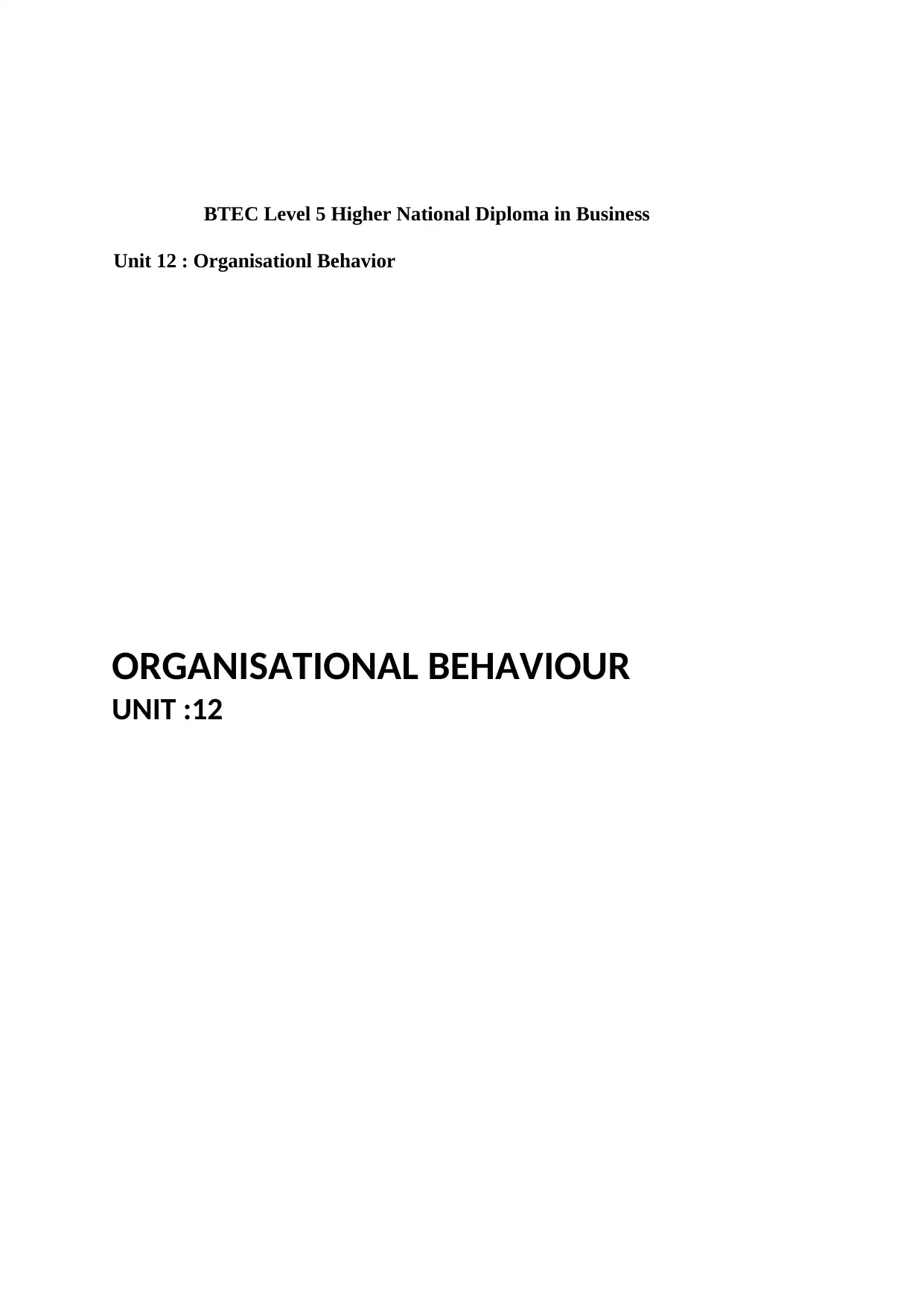
BTEC Level 5 Higher National Diploma in Business
Unit 12 : Organisationl Behavior
ORGANISATIONAL BEHAVIOUR
UNIT :12
Unit 12 : Organisationl Behavior
ORGANISATIONAL BEHAVIOUR
UNIT :12
Paraphrase This Document
Need a fresh take? Get an instant paraphrase of this document with our AI Paraphraser
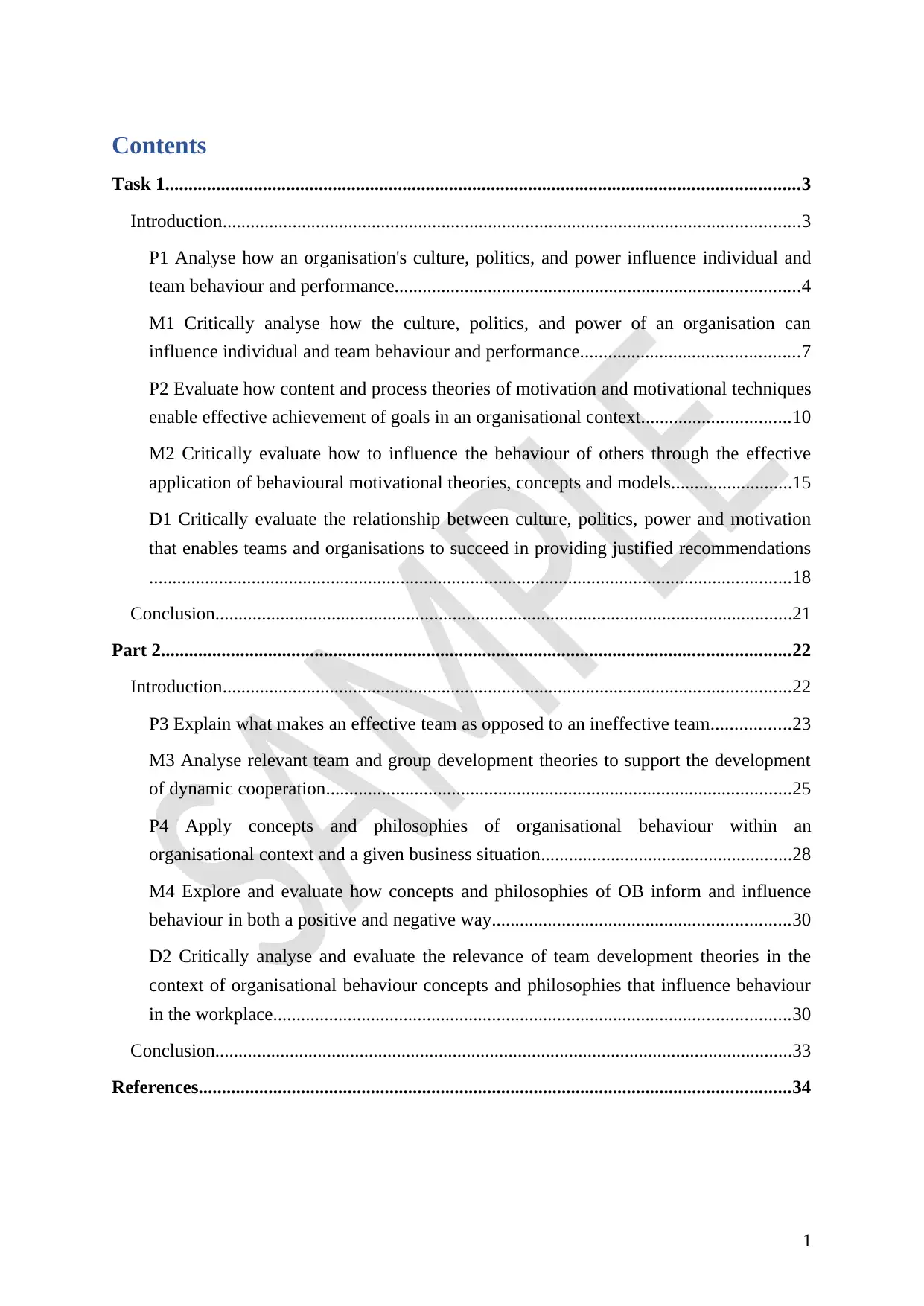
Contents
Task 1........................................................................................................................................3
Introduction............................................................................................................................3
P1 Analyse how an organisation's culture, politics, and power influence individual and
team behaviour and performance.......................................................................................4
M1 Critically analyse how the culture, politics, and power of an organisation can
influence individual and team behaviour and performance...............................................7
P2 Evaluate how content and process theories of motivation and motivational techniques
enable effective achievement of goals in an organisational context................................10
M2 Critically evaluate how to influence the behaviour of others through the effective
application of behavioural motivational theories, concepts and models..........................15
D1 Critically evaluate the relationship between culture, politics, power and motivation
that enables teams and organisations to succeed in providing justified recommendations
..........................................................................................................................................18
Conclusion............................................................................................................................21
Part 2.......................................................................................................................................22
Introduction..........................................................................................................................22
P3 Explain what makes an effective team as opposed to an ineffective team.................23
M3 Analyse relevant team and group development theories to support the development
of dynamic cooperation....................................................................................................25
P4 Apply concepts and philosophies of organisational behaviour within an
organisational context and a given business situation......................................................28
M4 Explore and evaluate how concepts and philosophies of OB inform and influence
behaviour in both a positive and negative way................................................................30
D2 Critically analyse and evaluate the relevance of team development theories in the
context of organisational behaviour concepts and philosophies that influence behaviour
in the workplace...............................................................................................................30
Conclusion............................................................................................................................33
References...............................................................................................................................34
1
Task 1........................................................................................................................................3
Introduction............................................................................................................................3
P1 Analyse how an organisation's culture, politics, and power influence individual and
team behaviour and performance.......................................................................................4
M1 Critically analyse how the culture, politics, and power of an organisation can
influence individual and team behaviour and performance...............................................7
P2 Evaluate how content and process theories of motivation and motivational techniques
enable effective achievement of goals in an organisational context................................10
M2 Critically evaluate how to influence the behaviour of others through the effective
application of behavioural motivational theories, concepts and models..........................15
D1 Critically evaluate the relationship between culture, politics, power and motivation
that enables teams and organisations to succeed in providing justified recommendations
..........................................................................................................................................18
Conclusion............................................................................................................................21
Part 2.......................................................................................................................................22
Introduction..........................................................................................................................22
P3 Explain what makes an effective team as opposed to an ineffective team.................23
M3 Analyse relevant team and group development theories to support the development
of dynamic cooperation....................................................................................................25
P4 Apply concepts and philosophies of organisational behaviour within an
organisational context and a given business situation......................................................28
M4 Explore and evaluate how concepts and philosophies of OB inform and influence
behaviour in both a positive and negative way................................................................30
D2 Critically analyse and evaluate the relevance of team development theories in the
context of organisational behaviour concepts and philosophies that influence behaviour
in the workplace...............................................................................................................30
Conclusion............................................................................................................................33
References...............................................................................................................................34
1
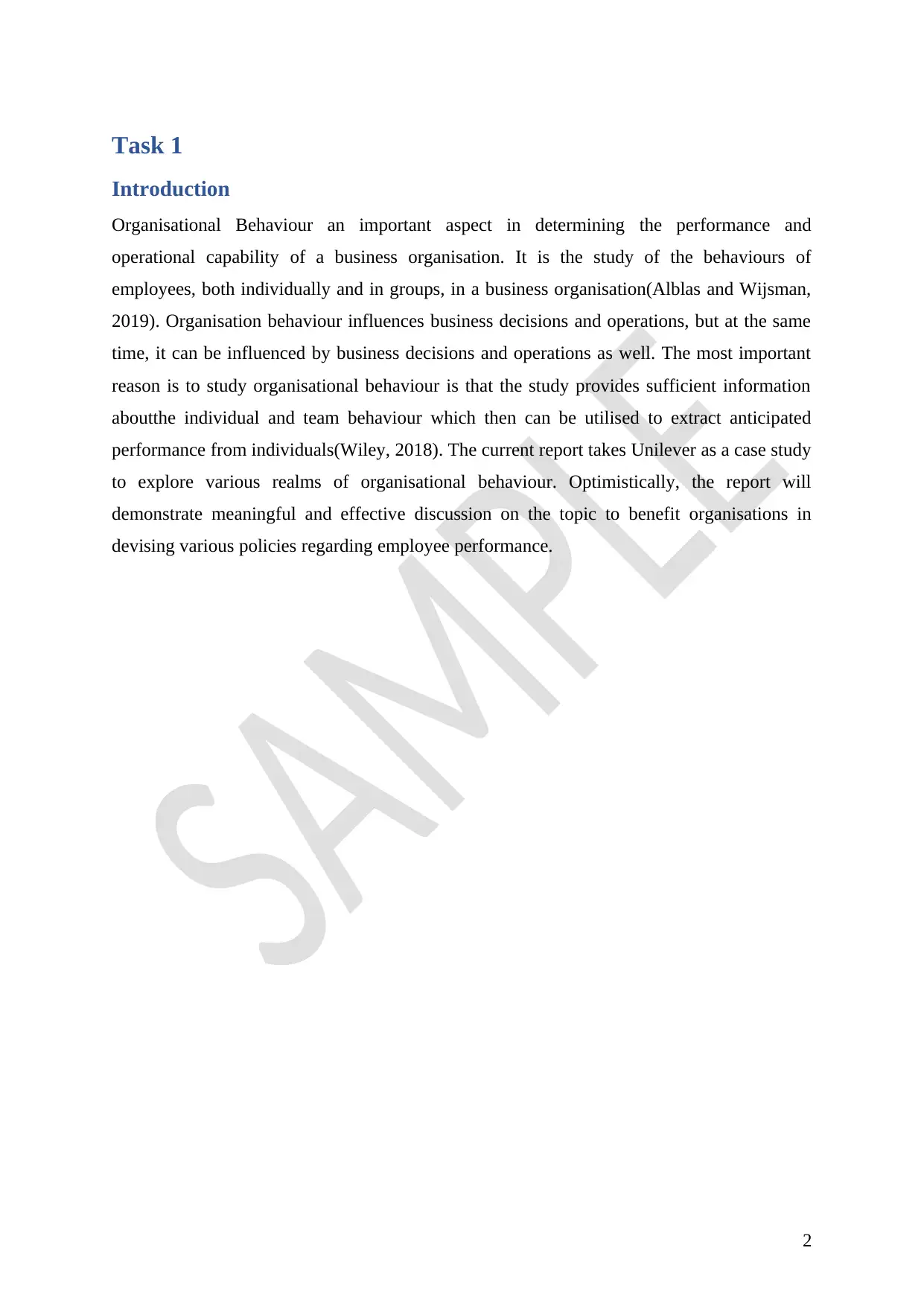
Task 1
Introduction
Organisational Behaviour an important aspect in determining the performance and
operational capability of a business organisation. It is the study of the behaviours of
employees, both individually and in groups, in a business organisation(Alblas and Wijsman,
2019). Organisation behaviour influences business decisions and operations, but at the same
time, it can be influenced by business decisions and operations as well. The most important
reason is to study organisational behaviour is that the study provides sufficient information
aboutthe individual and team behaviour which then can be utilised to extract anticipated
performance from individuals(Wiley, 2018). The current report takes Unilever as a case study
to explore various realms of organisational behaviour. Optimistically, the report will
demonstrate meaningful and effective discussion on the topic to benefit organisations in
devising various policies regarding employee performance.
2
Introduction
Organisational Behaviour an important aspect in determining the performance and
operational capability of a business organisation. It is the study of the behaviours of
employees, both individually and in groups, in a business organisation(Alblas and Wijsman,
2019). Organisation behaviour influences business decisions and operations, but at the same
time, it can be influenced by business decisions and operations as well. The most important
reason is to study organisational behaviour is that the study provides sufficient information
aboutthe individual and team behaviour which then can be utilised to extract anticipated
performance from individuals(Wiley, 2018). The current report takes Unilever as a case study
to explore various realms of organisational behaviour. Optimistically, the report will
demonstrate meaningful and effective discussion on the topic to benefit organisations in
devising various policies regarding employee performance.
2
⊘ This is a preview!⊘
Do you want full access?
Subscribe today to unlock all pages.

Trusted by 1+ million students worldwide
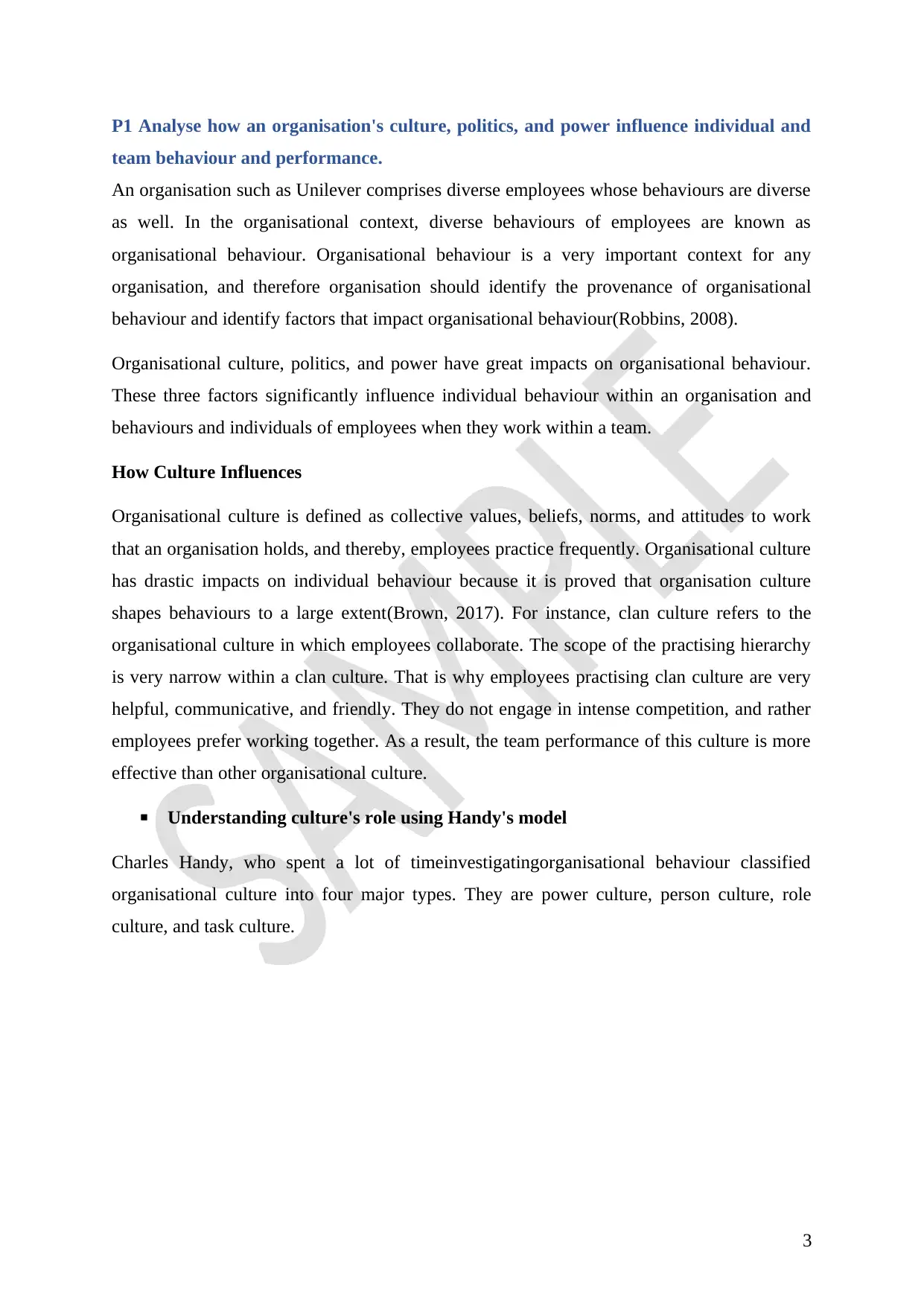
P1 Analyse how an organisation's culture, politics, and power influence individual and
team behaviour and performance.
An organisation such as Unilever comprises diverse employees whose behaviours are diverse
as well. In the organisational context, diverse behaviours of employees are known as
organisational behaviour. Organisational behaviour is a very important context for any
organisation, and therefore organisation should identify the provenance of organisational
behaviour and identify factors that impact organisational behaviour(Robbins, 2008).
Organisational culture, politics, and power have great impacts on organisational behaviour.
These three factors significantly influence individual behaviour within an organisation and
behaviours and individuals of employees when they work within a team.
How Culture Influences
Organisational culture is defined as collective values, beliefs, norms, and attitudes to work
that an organisation holds, and thereby, employees practice frequently. Organisational culture
has drastic impacts on individual behaviour because it is proved that organisation culture
shapes behaviours to a large extent(Brown, 2017). For instance, clan culture refers to the
organisational culture in which employees collaborate. The scope of the practising hierarchy
is very narrow within a clan culture. That is why employees practising clan culture are very
helpful, communicative, and friendly. They do not engage in intense competition, and rather
employees prefer working together. As a result, the team performance of this culture is more
effective than other organisational culture.
Understanding culture's role using Handy's model
Charles Handy, who spent a lot of timeinvestigatingorganisational behaviour classified
organisational culture into four major types. They are power culture, person culture, role
culture, and task culture.
3
team behaviour and performance.
An organisation such as Unilever comprises diverse employees whose behaviours are diverse
as well. In the organisational context, diverse behaviours of employees are known as
organisational behaviour. Organisational behaviour is a very important context for any
organisation, and therefore organisation should identify the provenance of organisational
behaviour and identify factors that impact organisational behaviour(Robbins, 2008).
Organisational culture, politics, and power have great impacts on organisational behaviour.
These three factors significantly influence individual behaviour within an organisation and
behaviours and individuals of employees when they work within a team.
How Culture Influences
Organisational culture is defined as collective values, beliefs, norms, and attitudes to work
that an organisation holds, and thereby, employees practice frequently. Organisational culture
has drastic impacts on individual behaviour because it is proved that organisation culture
shapes behaviours to a large extent(Brown, 2017). For instance, clan culture refers to the
organisational culture in which employees collaborate. The scope of the practising hierarchy
is very narrow within a clan culture. That is why employees practising clan culture are very
helpful, communicative, and friendly. They do not engage in intense competition, and rather
employees prefer working together. As a result, the team performance of this culture is more
effective than other organisational culture.
Understanding culture's role using Handy's model
Charles Handy, who spent a lot of timeinvestigatingorganisational behaviour classified
organisational culture into four major types. They are power culture, person culture, role
culture, and task culture.
3
Paraphrase This Document
Need a fresh take? Get an instant paraphrase of this document with our AI Paraphraser
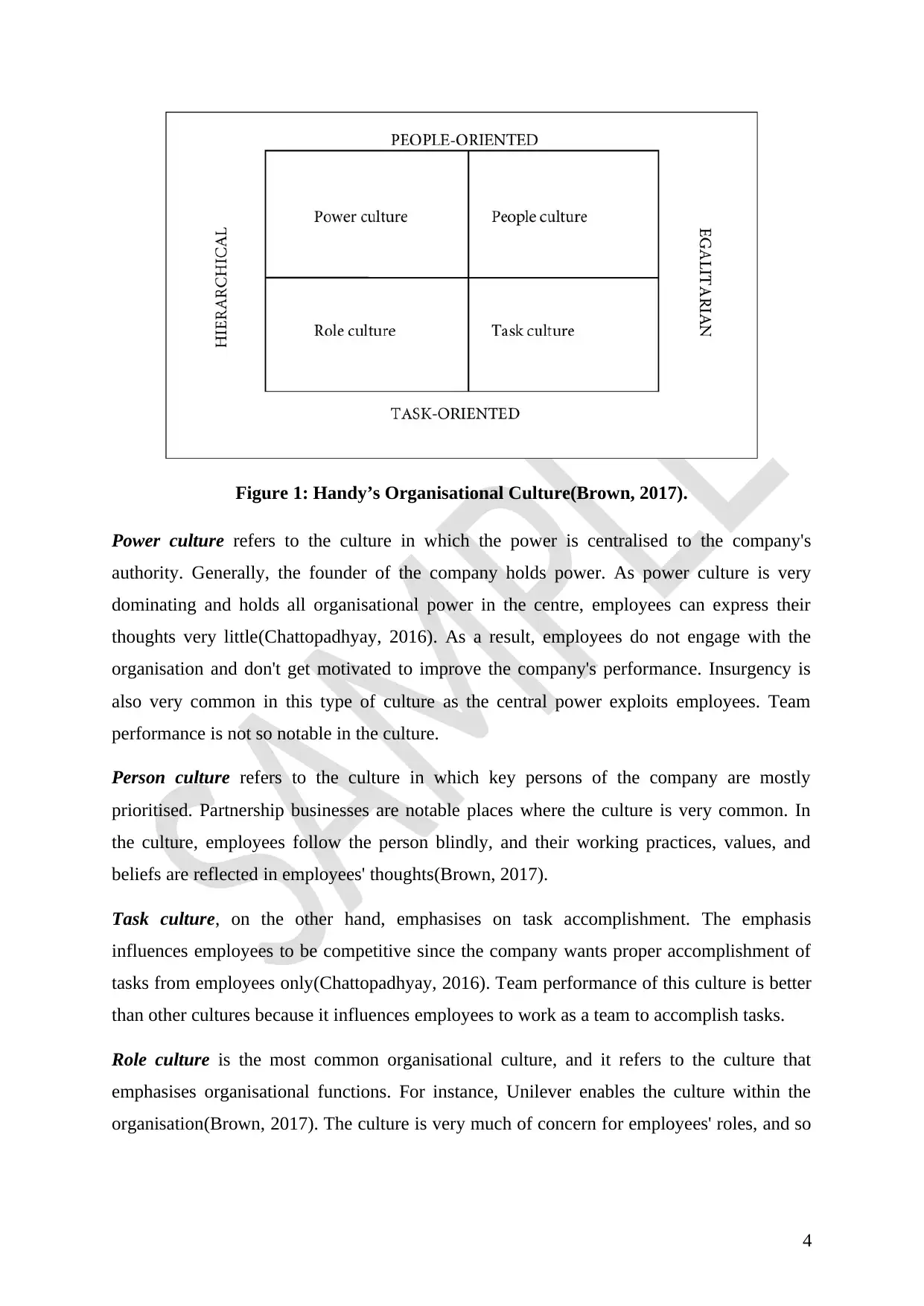
Figure 1: Handy’s Organisational Culture(Brown, 2017).
Power culture refers to the culture in which the power is centralised to the company's
authority. Generally, the founder of the company holds power. As power culture is very
dominating and holds all organisational power in the centre, employees can express their
thoughts very little(Chattopadhyay, 2016). As a result, employees do not engage with the
organisation and don't get motivated to improve the company's performance. Insurgency is
also very common in this type of culture as the central power exploits employees. Team
performance is not so notable in the culture.
Person culture refers to the culture in which key persons of the company are mostly
prioritised. Partnership businesses are notable places where the culture is very common. In
the culture, employees follow the person blindly, and their working practices, values, and
beliefs are reflected in employees' thoughts(Brown, 2017).
Task culture, on the other hand, emphasises on task accomplishment. The emphasis
influences employees to be competitive since the company wants proper accomplishment of
tasks from employees only(Chattopadhyay, 2016). Team performance of this culture is better
than other cultures because it influences employees to work as a team to accomplish tasks.
Role culture is the most common organisational culture, and it refers to the culture that
emphasises organisational functions. For instance, Unilever enables the culture within the
organisation(Brown, 2017). The culture is very much of concern for employees' roles, and so
4
Power culture refers to the culture in which the power is centralised to the company's
authority. Generally, the founder of the company holds power. As power culture is very
dominating and holds all organisational power in the centre, employees can express their
thoughts very little(Chattopadhyay, 2016). As a result, employees do not engage with the
organisation and don't get motivated to improve the company's performance. Insurgency is
also very common in this type of culture as the central power exploits employees. Team
performance is not so notable in the culture.
Person culture refers to the culture in which key persons of the company are mostly
prioritised. Partnership businesses are notable places where the culture is very common. In
the culture, employees follow the person blindly, and their working practices, values, and
beliefs are reflected in employees' thoughts(Brown, 2017).
Task culture, on the other hand, emphasises on task accomplishment. The emphasis
influences employees to be competitive since the company wants proper accomplishment of
tasks from employees only(Chattopadhyay, 2016). Team performance of this culture is better
than other cultures because it influences employees to work as a team to accomplish tasks.
Role culture is the most common organisational culture, and it refers to the culture that
emphasises organisational functions. For instance, Unilever enables the culture within the
organisation(Brown, 2017). The culture is very much of concern for employees' roles, and so
4
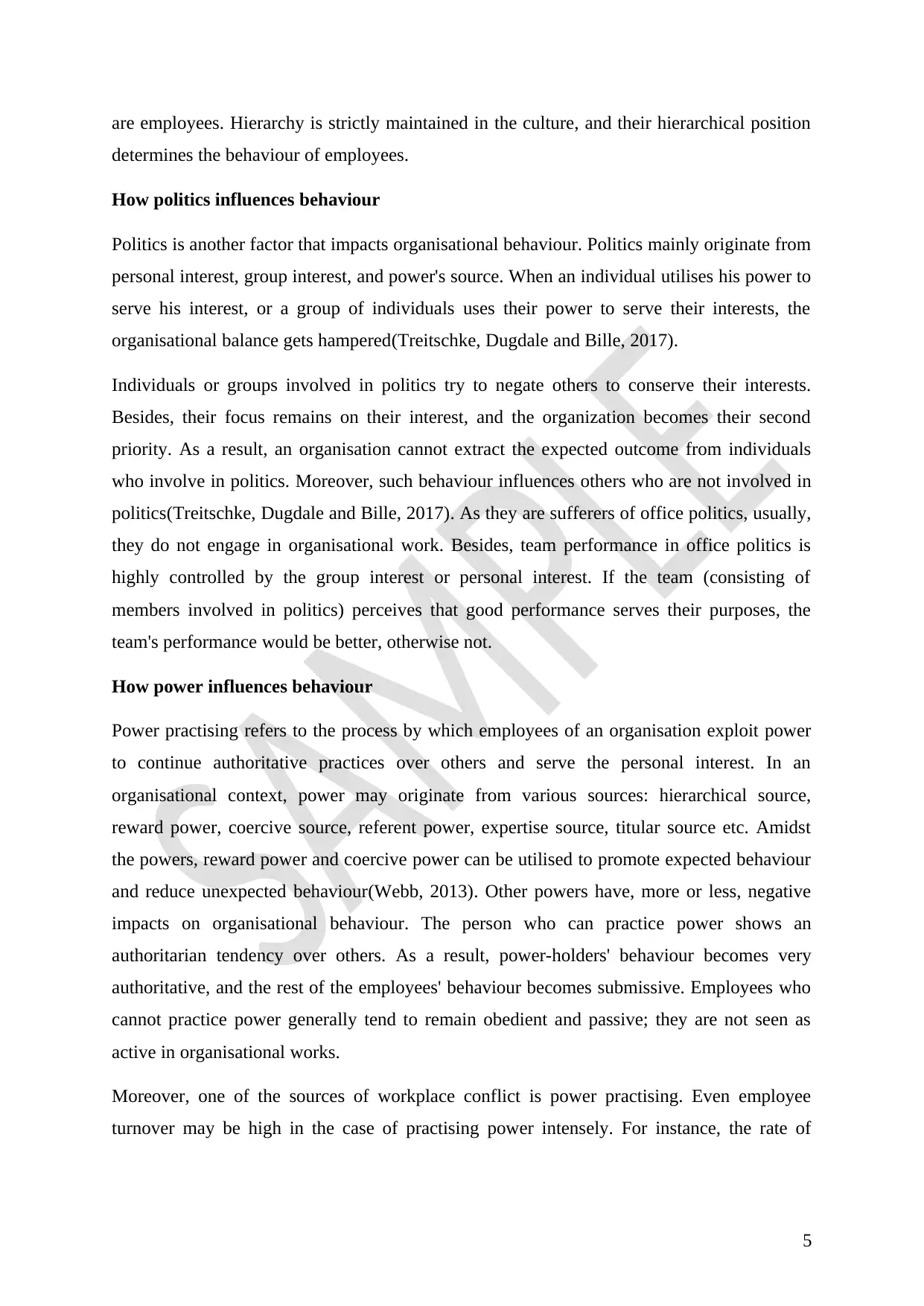
are employees. Hierarchy is strictly maintained in the culture, and their hierarchical position
determines the behaviour of employees.
How politics influences behaviour
Politics is another factor that impacts organisational behaviour. Politics mainly originate from
personal interest, group interest, and power's source. When an individual utilises his power to
serve his interest, or a group of individuals uses their power to serve their interests, the
organisational balance gets hampered(Treitschke, Dugdale and Bille, 2017).
Individuals or groups involved in politics try to negate others to conserve their interests.
Besides, their focus remains on their interest, and the organization becomes their second
priority. As a result, an organisation cannot extract the expected outcome from individuals
who involve in politics. Moreover, such behaviour influences others who are not involved in
politics(Treitschke, Dugdale and Bille, 2017). As they are sufferers of office politics, usually,
they do not engage in organisational work. Besides, team performance in office politics is
highly controlled by the group interest or personal interest. If the team (consisting of
members involved in politics) perceives that good performance serves their purposes, the
team's performance would be better, otherwise not.
How power influences behaviour
Power practising refers to the process by which employees of an organisation exploit power
to continue authoritative practices over others and serve the personal interest. In an
organisational context, power may originate from various sources: hierarchical source,
reward power, coercive source, referent power, expertise source, titular source etc. Amidst
the powers, reward power and coercive power can be utilised to promote expected behaviour
and reduce unexpected behaviour(Webb, 2013). Other powers have, more or less, negative
impacts on organisational behaviour. The person who can practice power shows an
authoritarian tendency over others. As a result, power-holders' behaviour becomes very
authoritative, and the rest of the employees' behaviour becomes submissive. Employees who
cannot practice power generally tend to remain obedient and passive; they are not seen as
active in organisational works.
Moreover, one of the sources of workplace conflict is power practising. Even employee
turnover may be high in the case of practising power intensely. For instance, the rate of
5
determines the behaviour of employees.
How politics influences behaviour
Politics is another factor that impacts organisational behaviour. Politics mainly originate from
personal interest, group interest, and power's source. When an individual utilises his power to
serve his interest, or a group of individuals uses their power to serve their interests, the
organisational balance gets hampered(Treitschke, Dugdale and Bille, 2017).
Individuals or groups involved in politics try to negate others to conserve their interests.
Besides, their focus remains on their interest, and the organization becomes their second
priority. As a result, an organisation cannot extract the expected outcome from individuals
who involve in politics. Moreover, such behaviour influences others who are not involved in
politics(Treitschke, Dugdale and Bille, 2017). As they are sufferers of office politics, usually,
they do not engage in organisational work. Besides, team performance in office politics is
highly controlled by the group interest or personal interest. If the team (consisting of
members involved in politics) perceives that good performance serves their purposes, the
team's performance would be better, otherwise not.
How power influences behaviour
Power practising refers to the process by which employees of an organisation exploit power
to continue authoritative practices over others and serve the personal interest. In an
organisational context, power may originate from various sources: hierarchical source,
reward power, coercive source, referent power, expertise source, titular source etc. Amidst
the powers, reward power and coercive power can be utilised to promote expected behaviour
and reduce unexpected behaviour(Webb, 2013). Other powers have, more or less, negative
impacts on organisational behaviour. The person who can practice power shows an
authoritarian tendency over others. As a result, power-holders' behaviour becomes very
authoritative, and the rest of the employees' behaviour becomes submissive. Employees who
cannot practice power generally tend to remain obedient and passive; they are not seen as
active in organisational works.
Moreover, one of the sources of workplace conflict is power practising. Even employee
turnover may be high in the case of practising power intensely. For instance, the rate of
5
⊘ This is a preview!⊘
Do you want full access?
Subscribe today to unlock all pages.

Trusted by 1+ million students worldwide
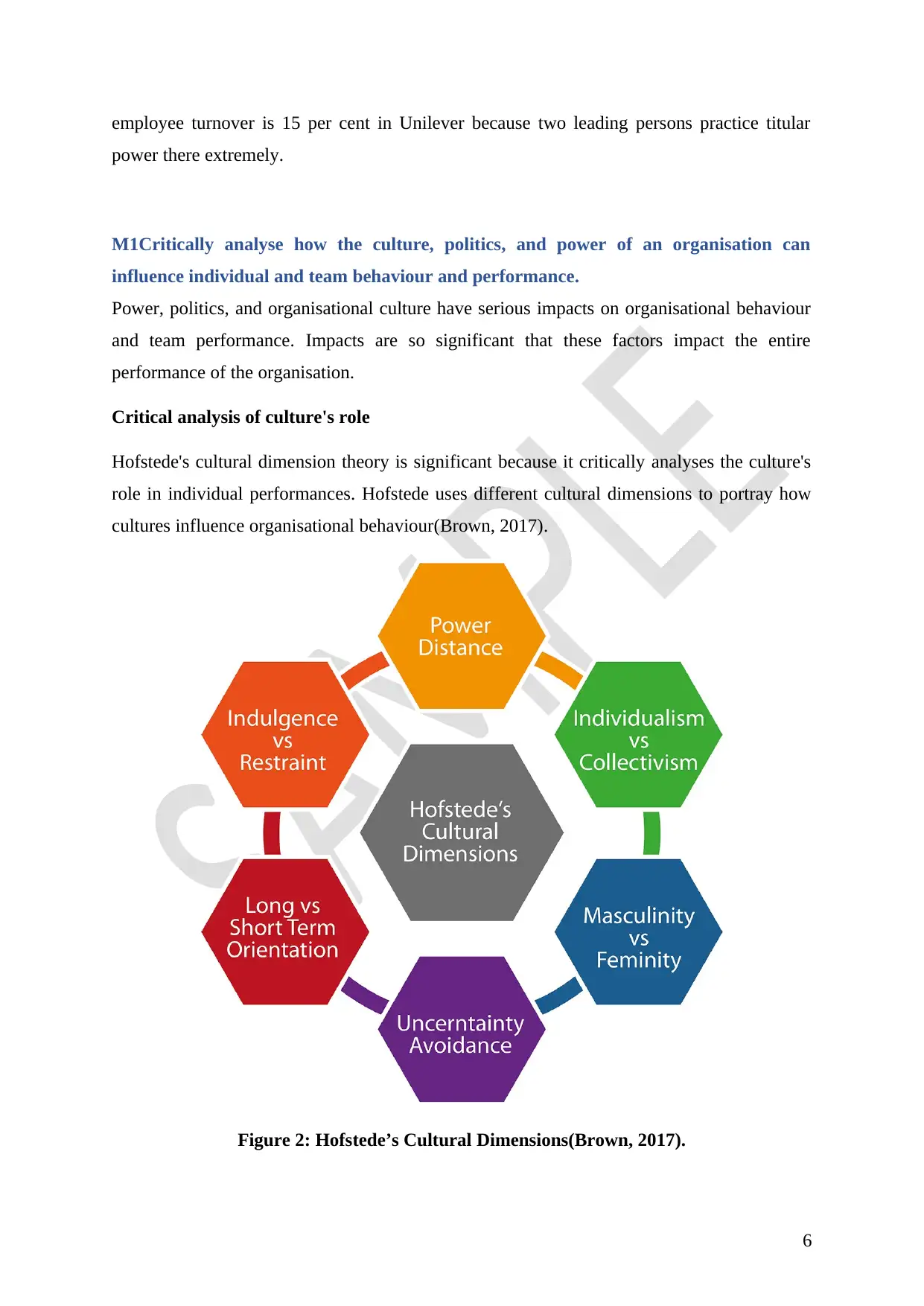
employee turnover is 15 per cent in Unilever because two leading persons practice titular
power there extremely.
M1Critically analyse how the culture, politics, and power of an organisation can
influence individual and team behaviour and performance.
Power, politics, and organisational culture have serious impacts on organisational behaviour
and team performance. Impacts are so significant that these factors impact the entire
performance of the organisation.
Critical analysis of culture's role
Hofstede's cultural dimension theory is significant because it critically analyses the culture's
role in individual performances. Hofstede uses different cultural dimensions to portray how
cultures influence organisational behaviour(Brown, 2017).
Figure 2: Hofstede’s Cultural Dimensions(Brown, 2017).
6
power there extremely.
M1Critically analyse how the culture, politics, and power of an organisation can
influence individual and team behaviour and performance.
Power, politics, and organisational culture have serious impacts on organisational behaviour
and team performance. Impacts are so significant that these factors impact the entire
performance of the organisation.
Critical analysis of culture's role
Hofstede's cultural dimension theory is significant because it critically analyses the culture's
role in individual performances. Hofstede uses different cultural dimensions to portray how
cultures influence organisational behaviour(Brown, 2017).
Figure 2: Hofstede’s Cultural Dimensions(Brown, 2017).
6
Paraphrase This Document
Need a fresh take? Get an instant paraphrase of this document with our AI Paraphraser
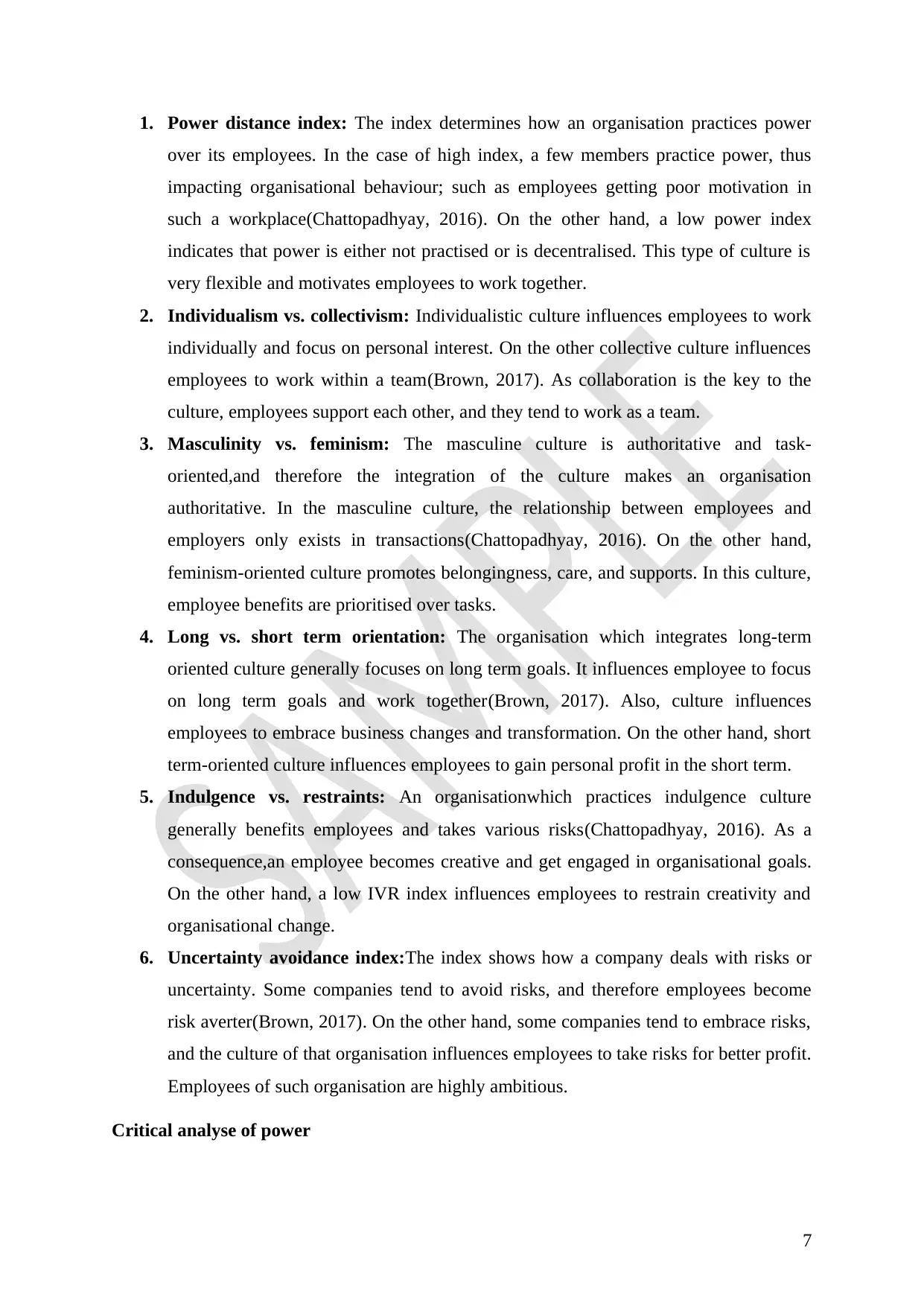
1. Power distance index: The index determines how an organisation practices power
over its employees. In the case of high index, a few members practice power, thus
impacting organisational behaviour; such as employees getting poor motivation in
such a workplace(Chattopadhyay, 2016). On the other hand, a low power index
indicates that power is either not practised or is decentralised. This type of culture is
very flexible and motivates employees to work together.
2. Individualism vs. collectivism: Individualistic culture influences employees to work
individually and focus on personal interest. On the other collective culture influences
employees to work within a team(Brown, 2017). As collaboration is the key to the
culture, employees support each other, and they tend to work as a team.
3. Masculinity vs. feminism: The masculine culture is authoritative and task-
oriented,and therefore the integration of the culture makes an organisation
authoritative. In the masculine culture, the relationship between employees and
employers only exists in transactions(Chattopadhyay, 2016). On the other hand,
feminism-oriented culture promotes belongingness, care, and supports. In this culture,
employee benefits are prioritised over tasks.
4. Long vs. short term orientation: The organisation which integrates long-term
oriented culture generally focuses on long term goals. It influences employee to focus
on long term goals and work together(Brown, 2017). Also, culture influences
employees to embrace business changes and transformation. On the other hand, short
term-oriented culture influences employees to gain personal profit in the short term.
5. Indulgence vs. restraints: An organisationwhich practices indulgence culture
generally benefits employees and takes various risks(Chattopadhyay, 2016). As a
consequence,an employee becomes creative and get engaged in organisational goals.
On the other hand, a low IVR index influences employees to restrain creativity and
organisational change.
6. Uncertainty avoidance index:The index shows how a company deals with risks or
uncertainty. Some companies tend to avoid risks, and therefore employees become
risk averter(Brown, 2017). On the other hand, some companies tend to embrace risks,
and the culture of that organisation influences employees to take risks for better profit.
Employees of such organisation are highly ambitious.
Critical analyse of power
7
over its employees. In the case of high index, a few members practice power, thus
impacting organisational behaviour; such as employees getting poor motivation in
such a workplace(Chattopadhyay, 2016). On the other hand, a low power index
indicates that power is either not practised or is decentralised. This type of culture is
very flexible and motivates employees to work together.
2. Individualism vs. collectivism: Individualistic culture influences employees to work
individually and focus on personal interest. On the other collective culture influences
employees to work within a team(Brown, 2017). As collaboration is the key to the
culture, employees support each other, and they tend to work as a team.
3. Masculinity vs. feminism: The masculine culture is authoritative and task-
oriented,and therefore the integration of the culture makes an organisation
authoritative. In the masculine culture, the relationship between employees and
employers only exists in transactions(Chattopadhyay, 2016). On the other hand,
feminism-oriented culture promotes belongingness, care, and supports. In this culture,
employee benefits are prioritised over tasks.
4. Long vs. short term orientation: The organisation which integrates long-term
oriented culture generally focuses on long term goals. It influences employee to focus
on long term goals and work together(Brown, 2017). Also, culture influences
employees to embrace business changes and transformation. On the other hand, short
term-oriented culture influences employees to gain personal profit in the short term.
5. Indulgence vs. restraints: An organisationwhich practices indulgence culture
generally benefits employees and takes various risks(Chattopadhyay, 2016). As a
consequence,an employee becomes creative and get engaged in organisational goals.
On the other hand, a low IVR index influences employees to restrain creativity and
organisational change.
6. Uncertainty avoidance index:The index shows how a company deals with risks or
uncertainty. Some companies tend to avoid risks, and therefore employees become
risk averter(Brown, 2017). On the other hand, some companies tend to embrace risks,
and the culture of that organisation influences employees to take risks for better profit.
Employees of such organisation are highly ambitious.
Critical analyse of power
7
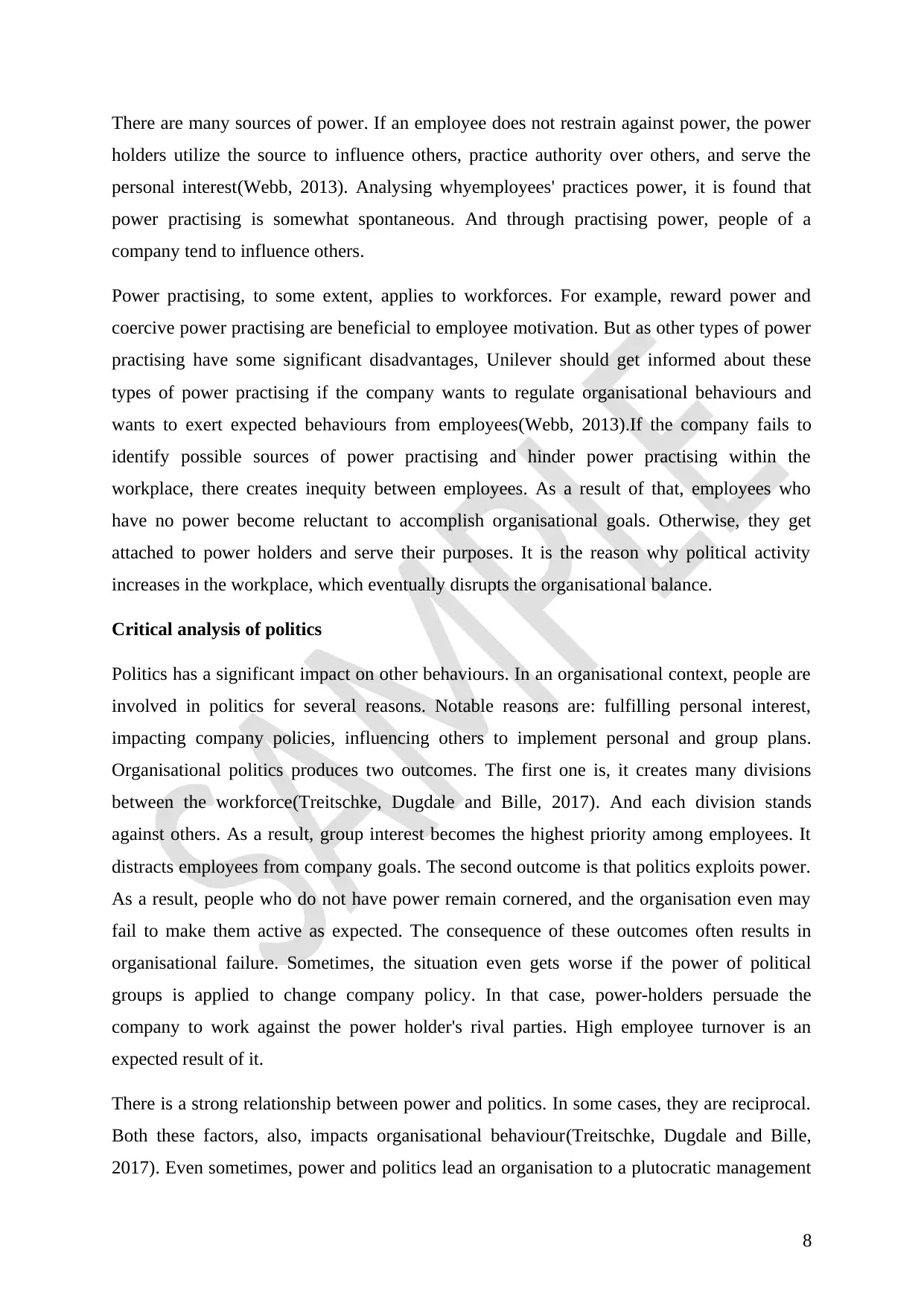
There are many sources of power. If an employee does not restrain against power, the power
holders utilize the source to influence others, practice authority over others, and serve the
personal interest(Webb, 2013). Analysing whyemployees' practices power, it is found that
power practising is somewhat spontaneous. And through practising power, people of a
company tend to influence others.
Power practising, to some extent, applies to workforces. For example, reward power and
coercive power practising are beneficial to employee motivation. But as other types of power
practising have some significant disadvantages, Unilever should get informed about these
types of power practising if the company wants to regulate organisational behaviours and
wants to exert expected behaviours from employees(Webb, 2013).If the company fails to
identify possible sources of power practising and hinder power practising within the
workplace, there creates inequity between employees. As a result of that, employees who
have no power become reluctant to accomplish organisational goals. Otherwise, they get
attached to power holders and serve their purposes. It is the reason why political activity
increases in the workplace, which eventually disrupts the organisational balance.
Critical analysis of politics
Politics has a significant impact on other behaviours. In an organisational context, people are
involved in politics for several reasons. Notable reasons are: fulfilling personal interest,
impacting company policies, influencing others to implement personal and group plans.
Organisational politics produces two outcomes. The first one is, it creates many divisions
between the workforce(Treitschke, Dugdale and Bille, 2017). And each division stands
against others. As a result, group interest becomes the highest priority among employees. It
distracts employees from company goals. The second outcome is that politics exploits power.
As a result, people who do not have power remain cornered, and the organisation even may
fail to make them active as expected. The consequence of these outcomes often results in
organisational failure. Sometimes, the situation even gets worse if the power of political
groups is applied to change company policy. In that case, power-holders persuade the
company to work against the power holder's rival parties. High employee turnover is an
expected result of it.
There is a strong relationship between power and politics. In some cases, they are reciprocal.
Both these factors, also, impacts organisational behaviour(Treitschke, Dugdale and Bille,
2017). Even sometimes, power and politics lead an organisation to a plutocratic management
8
holders utilize the source to influence others, practice authority over others, and serve the
personal interest(Webb, 2013). Analysing whyemployees' practices power, it is found that
power practising is somewhat spontaneous. And through practising power, people of a
company tend to influence others.
Power practising, to some extent, applies to workforces. For example, reward power and
coercive power practising are beneficial to employee motivation. But as other types of power
practising have some significant disadvantages, Unilever should get informed about these
types of power practising if the company wants to regulate organisational behaviours and
wants to exert expected behaviours from employees(Webb, 2013).If the company fails to
identify possible sources of power practising and hinder power practising within the
workplace, there creates inequity between employees. As a result of that, employees who
have no power become reluctant to accomplish organisational goals. Otherwise, they get
attached to power holders and serve their purposes. It is the reason why political activity
increases in the workplace, which eventually disrupts the organisational balance.
Critical analysis of politics
Politics has a significant impact on other behaviours. In an organisational context, people are
involved in politics for several reasons. Notable reasons are: fulfilling personal interest,
impacting company policies, influencing others to implement personal and group plans.
Organisational politics produces two outcomes. The first one is, it creates many divisions
between the workforce(Treitschke, Dugdale and Bille, 2017). And each division stands
against others. As a result, group interest becomes the highest priority among employees. It
distracts employees from company goals. The second outcome is that politics exploits power.
As a result, people who do not have power remain cornered, and the organisation even may
fail to make them active as expected. The consequence of these outcomes often results in
organisational failure. Sometimes, the situation even gets worse if the power of political
groups is applied to change company policy. In that case, power-holders persuade the
company to work against the power holder's rival parties. High employee turnover is an
expected result of it.
There is a strong relationship between power and politics. In some cases, they are reciprocal.
Both these factors, also, impacts organisational behaviour(Treitschke, Dugdale and Bille,
2017). Even sometimes, power and politics lead an organisation to a plutocratic management
8
⊘ This is a preview!⊘
Do you want full access?
Subscribe today to unlock all pages.

Trusted by 1+ million students worldwide
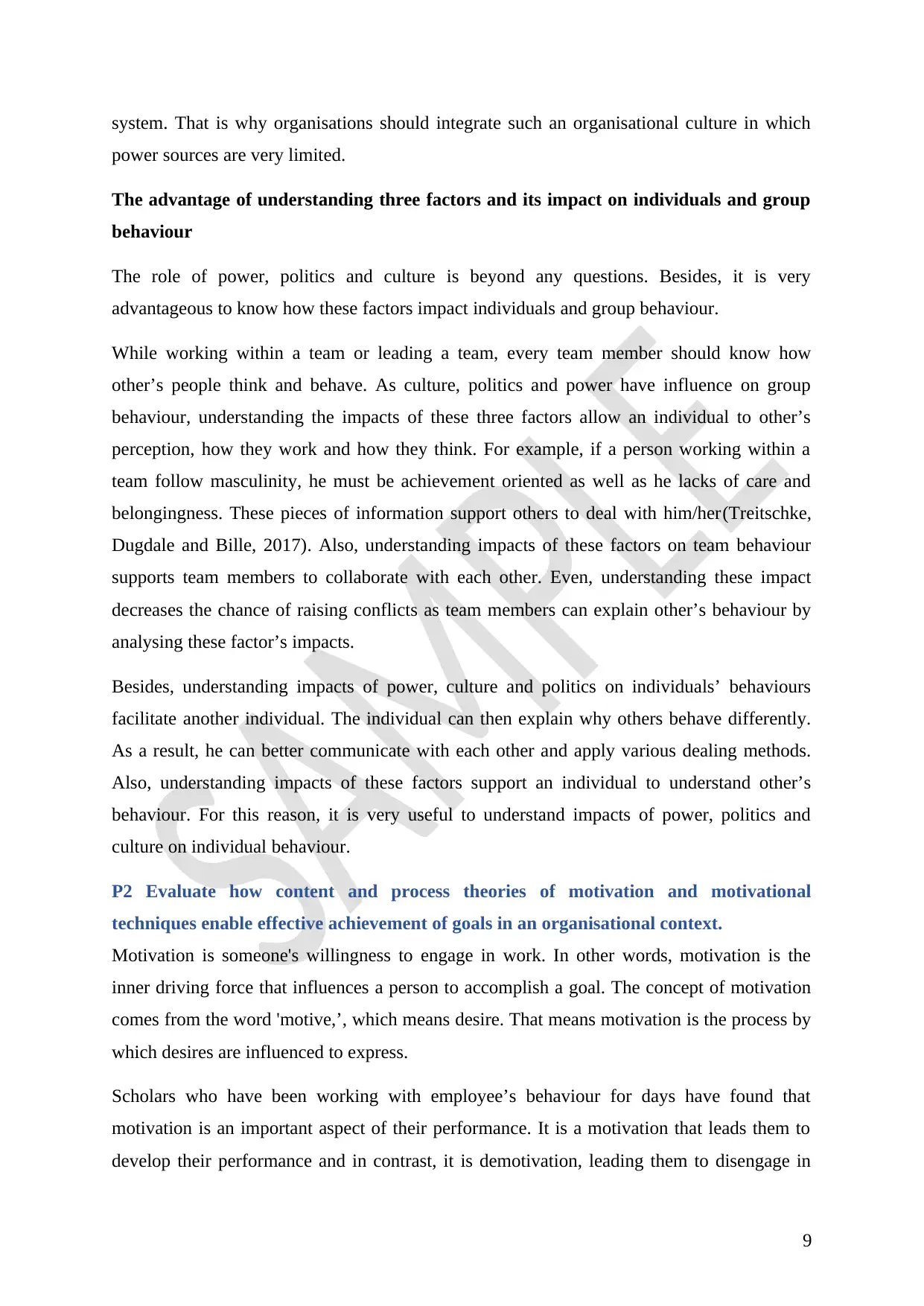
system. That is why organisations should integrate such an organisational culture in which
power sources are very limited.
The advantage of understanding three factors and its impact on individuals and group
behaviour
The role of power, politics and culture is beyond any questions. Besides, it is very
advantageous to know how these factors impact individuals and group behaviour.
While working within a team or leading a team, every team member should know how
other’s people think and behave. As culture, politics and power have influence on group
behaviour, understanding the impacts of these three factors allow an individual to other’s
perception, how they work and how they think. For example, if a person working within a
team follow masculinity, he must be achievement oriented as well as he lacks of care and
belongingness. These pieces of information support others to deal with him/her(Treitschke,
Dugdale and Bille, 2017). Also, understanding impacts of these factors on team behaviour
supports team members to collaborate with each other. Even, understanding these impact
decreases the chance of raising conflicts as team members can explain other’s behaviour by
analysing these factor’s impacts.
Besides, understanding impacts of power, culture and politics on individuals’ behaviours
facilitate another individual. The individual can then explain why others behave differently.
As a result, he can better communicate with each other and apply various dealing methods.
Also, understanding impacts of these factors support an individual to understand other’s
behaviour. For this reason, it is very useful to understand impacts of power, politics and
culture on individual behaviour.
P2 Evaluate how content and process theories of motivation and motivational
techniques enable effective achievement of goals in an organisational context.
Motivation is someone's willingness to engage in work. In other words, motivation is the
inner driving force that influences a person to accomplish a goal. The concept of motivation
comes from the word 'motive,’, which means desire. That means motivation is the process by
which desires are influenced to express.
Scholars who have been working with employee’s behaviour for days have found that
motivation is an important aspect of their performance. It is a motivation that leads them to
develop their performance and in contrast, it is demotivation, leading them to disengage in
9
power sources are very limited.
The advantage of understanding three factors and its impact on individuals and group
behaviour
The role of power, politics and culture is beyond any questions. Besides, it is very
advantageous to know how these factors impact individuals and group behaviour.
While working within a team or leading a team, every team member should know how
other’s people think and behave. As culture, politics and power have influence on group
behaviour, understanding the impacts of these three factors allow an individual to other’s
perception, how they work and how they think. For example, if a person working within a
team follow masculinity, he must be achievement oriented as well as he lacks of care and
belongingness. These pieces of information support others to deal with him/her(Treitschke,
Dugdale and Bille, 2017). Also, understanding impacts of these factors on team behaviour
supports team members to collaborate with each other. Even, understanding these impact
decreases the chance of raising conflicts as team members can explain other’s behaviour by
analysing these factor’s impacts.
Besides, understanding impacts of power, culture and politics on individuals’ behaviours
facilitate another individual. The individual can then explain why others behave differently.
As a result, he can better communicate with each other and apply various dealing methods.
Also, understanding impacts of these factors support an individual to understand other’s
behaviour. For this reason, it is very useful to understand impacts of power, politics and
culture on individual behaviour.
P2 Evaluate how content and process theories of motivation and motivational
techniques enable effective achievement of goals in an organisational context.
Motivation is someone's willingness to engage in work. In other words, motivation is the
inner driving force that influences a person to accomplish a goal. The concept of motivation
comes from the word 'motive,’, which means desire. That means motivation is the process by
which desires are influenced to express.
Scholars who have been working with employee’s behaviour for days have found that
motivation is an important aspect of their performance. It is a motivation that leads them to
develop their performance and in contrast, it is demotivation, leading them to disengage in
9
Paraphrase This Document
Need a fresh take? Get an instant paraphrase of this document with our AI Paraphraser
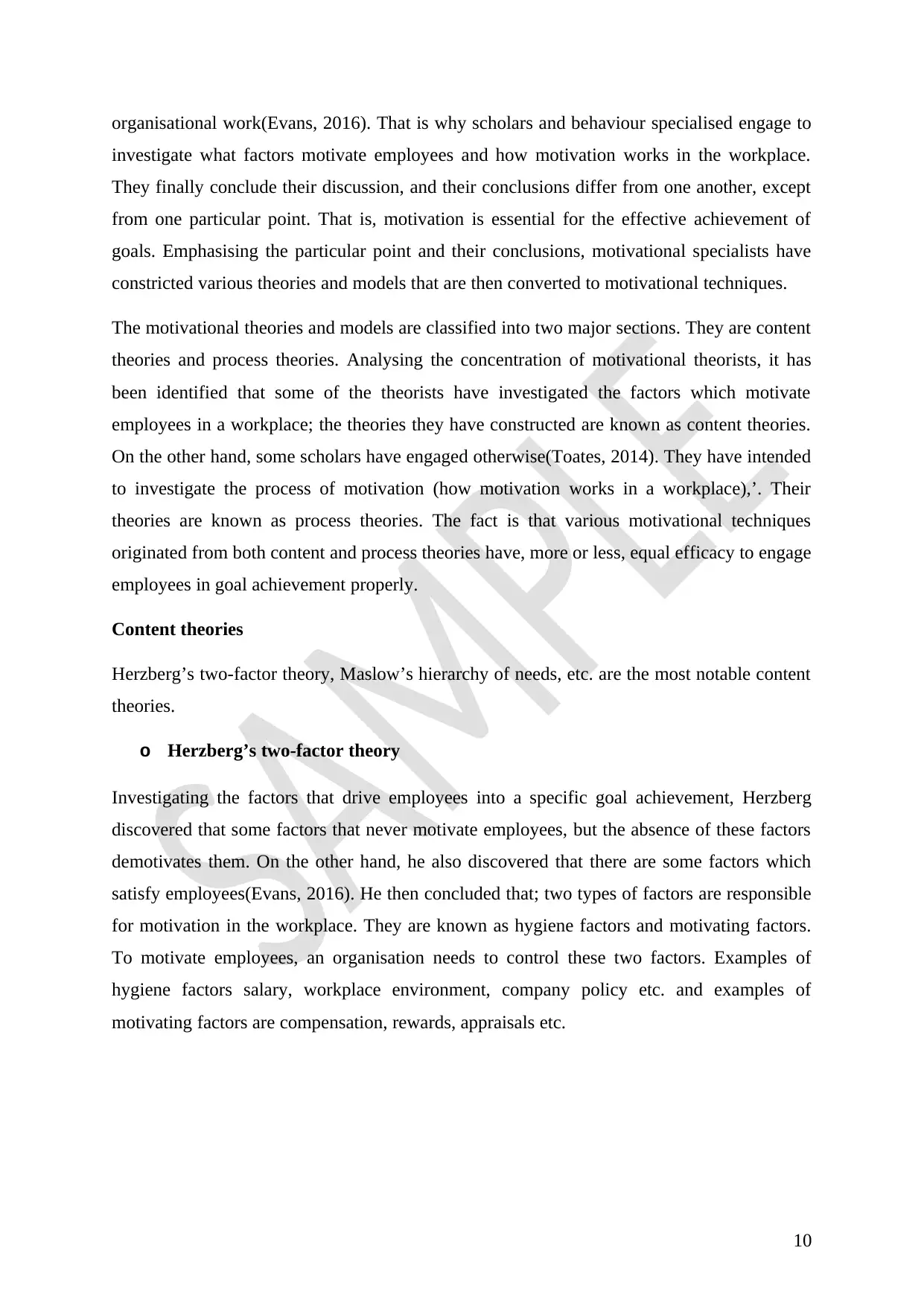
organisational work(Evans, 2016). That is why scholars and behaviour specialised engage to
investigate what factors motivate employees and how motivation works in the workplace.
They finally conclude their discussion, and their conclusions differ from one another, except
from one particular point. That is, motivation is essential for the effective achievement of
goals. Emphasising the particular point and their conclusions, motivational specialists have
constricted various theories and models that are then converted to motivational techniques.
The motivational theories and models are classified into two major sections. They are content
theories and process theories. Analysing the concentration of motivational theorists, it has
been identified that some of the theorists have investigated the factors which motivate
employees in a workplace; the theories they have constructed are known as content theories.
On the other hand, some scholars have engaged otherwise(Toates, 2014). They have intended
to investigate the process of motivation (how motivation works in a workplace),’. Their
theories are known as process theories. The fact is that various motivational techniques
originated from both content and process theories have, more or less, equal efficacy to engage
employees in goal achievement properly.
Content theories
Herzberg’s two-factor theory, Maslow’s hierarchy of needs, etc. are the most notable content
theories.
o Herzberg’s two-factor theory
Investigating the factors that drive employees into a specific goal achievement, Herzberg
discovered that some factors that never motivate employees, but the absence of these factors
demotivates them. On the other hand, he also discovered that there are some factors which
satisfy employees(Evans, 2016). He then concluded that; two types of factors are responsible
for motivation in the workplace. They are known as hygiene factors and motivating factors.
To motivate employees, an organisation needs to control these two factors. Examples of
hygiene factors salary, workplace environment, company policy etc. and examples of
motivating factors are compensation, rewards, appraisals etc.
10
investigate what factors motivate employees and how motivation works in the workplace.
They finally conclude their discussion, and their conclusions differ from one another, except
from one particular point. That is, motivation is essential for the effective achievement of
goals. Emphasising the particular point and their conclusions, motivational specialists have
constricted various theories and models that are then converted to motivational techniques.
The motivational theories and models are classified into two major sections. They are content
theories and process theories. Analysing the concentration of motivational theorists, it has
been identified that some of the theorists have investigated the factors which motivate
employees in a workplace; the theories they have constructed are known as content theories.
On the other hand, some scholars have engaged otherwise(Toates, 2014). They have intended
to investigate the process of motivation (how motivation works in a workplace),’. Their
theories are known as process theories. The fact is that various motivational techniques
originated from both content and process theories have, more or less, equal efficacy to engage
employees in goal achievement properly.
Content theories
Herzberg’s two-factor theory, Maslow’s hierarchy of needs, etc. are the most notable content
theories.
o Herzberg’s two-factor theory
Investigating the factors that drive employees into a specific goal achievement, Herzberg
discovered that some factors that never motivate employees, but the absence of these factors
demotivates them. On the other hand, he also discovered that there are some factors which
satisfy employees(Evans, 2016). He then concluded that; two types of factors are responsible
for motivation in the workplace. They are known as hygiene factors and motivating factors.
To motivate employees, an organisation needs to control these two factors. Examples of
hygiene factors salary, workplace environment, company policy etc. and examples of
motivating factors are compensation, rewards, appraisals etc.
10
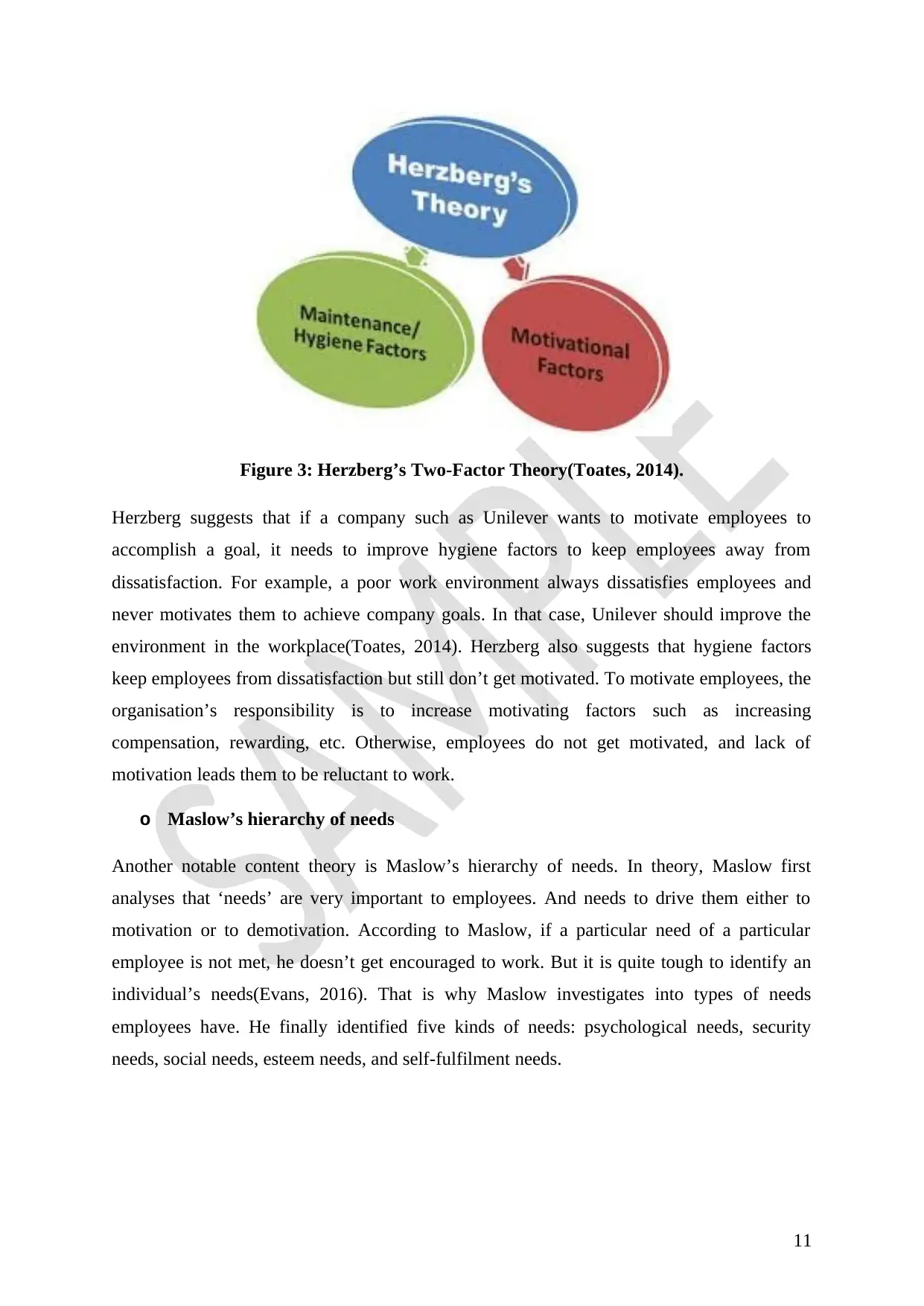
Figure 3: Herzberg’s Two-Factor Theory(Toates, 2014).
Herzberg suggests that if a company such as Unilever wants to motivate employees to
accomplish a goal, it needs to improve hygiene factors to keep employees away from
dissatisfaction. For example, a poor work environment always dissatisfies employees and
never motivates them to achieve company goals. In that case, Unilever should improve the
environment in the workplace(Toates, 2014). Herzberg also suggests that hygiene factors
keep employees from dissatisfaction but still don’t get motivated. To motivate employees, the
organisation’s responsibility is to increase motivating factors such as increasing
compensation, rewarding, etc. Otherwise, employees do not get motivated, and lack of
motivation leads them to be reluctant to work.
o Maslow’s hierarchy of needs
Another notable content theory is Maslow’s hierarchy of needs. In theory, Maslow first
analyses that ‘needs’ are very important to employees. And needs to drive them either to
motivation or to demotivation. According to Maslow, if a particular need of a particular
employee is not met, he doesn’t get encouraged to work. But it is quite tough to identify an
individual’s needs(Evans, 2016). That is why Maslow investigates into types of needs
employees have. He finally identified five kinds of needs: psychological needs, security
needs, social needs, esteem needs, and self-fulfilment needs.
11
Herzberg suggests that if a company such as Unilever wants to motivate employees to
accomplish a goal, it needs to improve hygiene factors to keep employees away from
dissatisfaction. For example, a poor work environment always dissatisfies employees and
never motivates them to achieve company goals. In that case, Unilever should improve the
environment in the workplace(Toates, 2014). Herzberg also suggests that hygiene factors
keep employees from dissatisfaction but still don’t get motivated. To motivate employees, the
organisation’s responsibility is to increase motivating factors such as increasing
compensation, rewarding, etc. Otherwise, employees do not get motivated, and lack of
motivation leads them to be reluctant to work.
o Maslow’s hierarchy of needs
Another notable content theory is Maslow’s hierarchy of needs. In theory, Maslow first
analyses that ‘needs’ are very important to employees. And needs to drive them either to
motivation or to demotivation. According to Maslow, if a particular need of a particular
employee is not met, he doesn’t get encouraged to work. But it is quite tough to identify an
individual’s needs(Evans, 2016). That is why Maslow investigates into types of needs
employees have. He finally identified five kinds of needs: psychological needs, security
needs, social needs, esteem needs, and self-fulfilment needs.
11
⊘ This is a preview!⊘
Do you want full access?
Subscribe today to unlock all pages.

Trusted by 1+ million students worldwide
1 out of 34
Related Documents
Your All-in-One AI-Powered Toolkit for Academic Success.
+13062052269
info@desklib.com
Available 24*7 on WhatsApp / Email
![[object Object]](/_next/static/media/star-bottom.7253800d.svg)
Unlock your academic potential
Copyright © 2020–2025 A2Z Services. All Rights Reserved. Developed and managed by ZUCOL.



